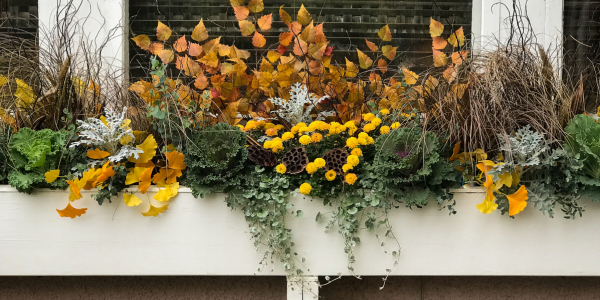Fall is the perfect time to give your yard some attention and prepare it for the colder months. While many people focus on spring and summer for their landscaping, fall offers a unique opportunity to boost your home’s curb appeal and set the stage for a healthy, vibrant yard come spring. Whether you’re looking to tidy up before winter or add some autumn color, these tips will help enhance your home’s exterior.
Why Fall Landscaping is Important
Fall landscaping is not just about maintaining the beauty of your yard as the seasons change. It also plays a vital role in keeping your lawn and plants healthy. By preparing your landscape in the fall, you’ll give your plants the strength they need to survive winter and thrive in the spring. Plus, a well-maintained yard adds curb appeal and can even increase your home’s value. At Lockstep Realty, a team affiliated with eXp Realty, we believe that enhancing your home’s exterior through landscaping is one of the best ways to make a strong first impression on potential buyers.
Clean Up and Maintain Your Lawn
One of the first things to do in fall is clear your lawn of fallen leaves and debris. While those autumn leaves may look pretty, leaving them on your lawn for too long can suffocate your grass and create the perfect environment for mold and fungus to grow. Be sure to rake regularly and consider aerating your lawn. Aeration helps loosen compacted soil and allows water, air, and nutrients to reach the grass roots, promoting healthy growth during the cooler months.
Fertilize Your Lawn
Fall is an excellent time to fertilize your lawn. As temperatures drop, your grass shifts its energy from growing leaves to developing deeper roots. Applying a slow-release fertilizer will help your lawn absorb essential nutrients that will sustain it through the winter. Look for a fertilizer high in nitrogen, as it’s ideal for cool-season grasses like fescue and bluegrass. Timing is key—apply fertilizer about two weeks before the first expected frost to get the best results.
Planting Fall Perennials
Fall is a great time to plant perennials that will bloom beautifully the following year. Flowers like mums, pansies, and asters not only add a splash of color to your yard, but they’re also hardy enough to withstand cool temperatures. Additionally, planting bulbs like tulips and daffodils in the fall ensures a colorful display come spring. If you’re unsure which plants are best for your area, opt for native species that are well-suited to your local climate.
Mulching: A Fall Must-Do
Adding mulch in the fall helps protect your plants from the coming cold. By placing a thick layer of mulch around the base of trees, shrubs, and garden beds, you’ll help insulate the roots from freezing temperatures. Mulch also helps retain moisture in the soil, reduces weeds, and improves soil structure. Opt for organic mulch like shredded bark, wood chips, or leaves, which break down over time and enrich the soil.
Tree and Shrub Care
Fall is the perfect time to prune your shrubs and trees. By cutting back dead or overgrown branches, you’ll encourage healthier growth in the spring. For trees, this is also the ideal time to plant new ones. Trees planted in the fall have plenty of time to establish strong roots before the ground freezes. Make sure to water your trees deeply before winter sets in, and consider wrapping young trees with burlap to protect them from harsh winds and snow.
Add Fall Decor Elements
If you want to enhance your home’s curb appeal even further, consider incorporating fall decor into your landscape. Simple elements like pumpkins, hay bales, and seasonal wreaths can create a warm, welcoming look. Natural materials such as gourds, dried corn, and colorful leaves make for eco-friendly decorations that reflect the beauty of the season without harming the environment.
Outdoor Lighting for Shorter Days
As the days grow shorter, outdoor lighting becomes more important. Installing low-voltage or solar-powered landscape lighting can illuminate pathways, gardens, and entryways, creating both beauty and safety. Lighting can also be used to highlight focal points in your yard, like trees, statues, or a beautiful fall wreath on your front door. Well-placed lighting adds a cozy ambiance to your outdoor space and makes your home stand out as the sun sets earlier.
Consider a Fall Clean-Up Service
For those who find themselves short on time, hiring a professional landscaping service for a fall clean-up is a great option. Many services offer fall packages that include leaf removal, pruning, fertilizing, and winter preparation. This can help extend the life of your landscaping investments and ensure that your yard looks its best going into winter. By outsourcing this task, you’ll have more time to enjoy the season and less to worry about when the snow starts falling.
Prepare for Winter with Fall Hardscaping
Fall isn’t just for planting and pruning; it’s also the perfect time to address any hardscaping projects. Before the ground freezes, repair walkways, patios, and driveways to avoid further damage during winter. If you’re thinking about adding a new patio, stone pathway, or retaining wall, fall is an ideal time to get the work done. Not only will it improve the functionality of your outdoor space, but it will also increase your home’s appeal for potential buyers.
Install Cold-Weather Plants
While many plants go dormant in the winter, some thrive in cold conditions. Consider adding cold-weather plants like evergreens, holly, and ornamental grasses to your landscape. These plants add color and structure to your yard throughout the winter, ensuring that your home’s exterior doesn’t lose its appeal after the fall leaves are gone. Evergreens, in particular, are great for adding year-round greenery and privacy to your property.
Watering Guidelines for Fall
As temperatures drop, it’s easy to forget that your plants still need water. Gradually reduce your watering frequency but continue to hydrate your plants until the ground freezes. This helps them store up the moisture they need to survive winter. Don’t forget to winterize your irrigation system by draining it to prevent freezing and cracking. Proper watering in the fall is essential for ensuring your plants are well-hydrated when spring arrives.
Composting: Preparing for Next Spring
Fall is an excellent time to start a compost pile. Use fallen leaves, grass clippings, and garden waste to create nutrient-rich compost that will be ready to use in the spring. Composting not only helps reduce waste, but it also provides an excellent source of organic matter to improve your soil’s health. By starting your compost pile now, you’ll have a head start on your garden come springtime.
Landscape for Wildlife
Fall landscaping isn’t just about aesthetics; it’s also a great opportunity to create a haven for local wildlife. Planting shrubs that produce berries or adding bird feeders can attract birds and small animals, which will help keep your yard lively during the colder months. Providing shelter for wildlife with native plants and leaving some fallen leaves in garden beds can support the local ecosystem and create a more dynamic landscape.
Final Thoughts
Fall landscaping is an essential part of maintaining your home’s curb appeal and preparing your yard for winter. By following these tips, you can ensure that your home looks beautiful through the fall and into the colder months. Start early and enjoy the benefits of a well-maintained yard all year long. And if you’re looking for more home improvement tips or advice on increasing your home’s value, feel free to reach out to the Lockstep Realty team at eXp Realty. We’re always here to help.



